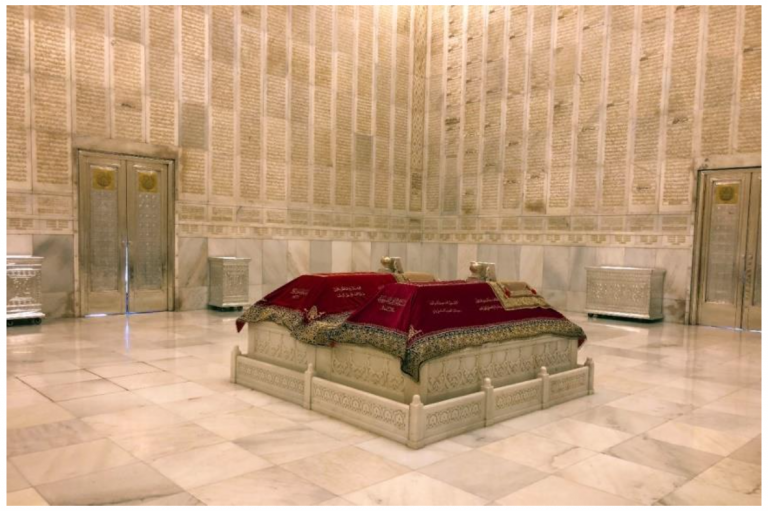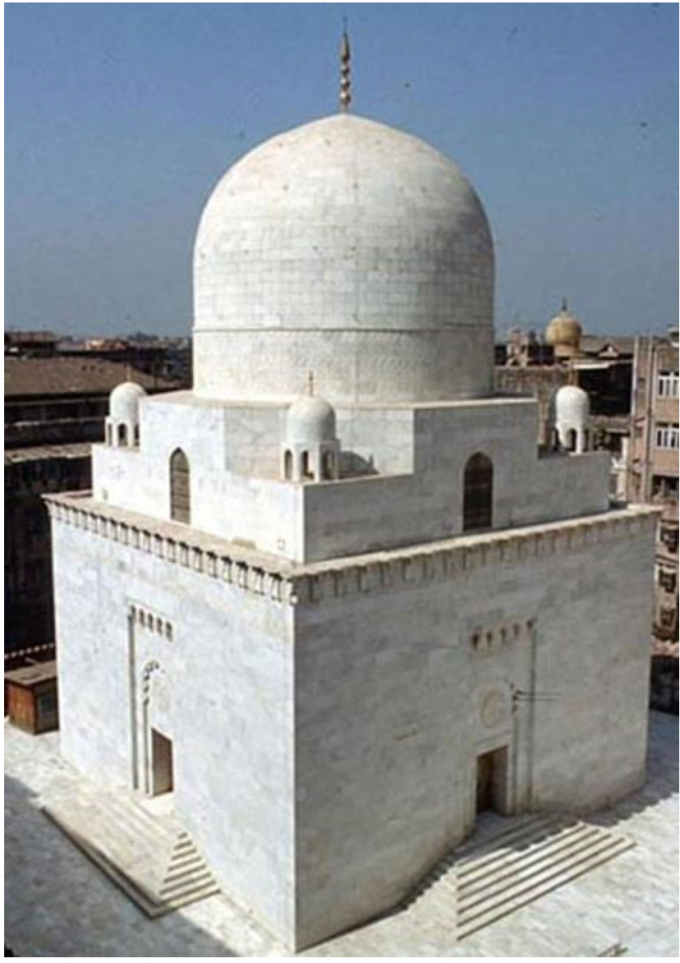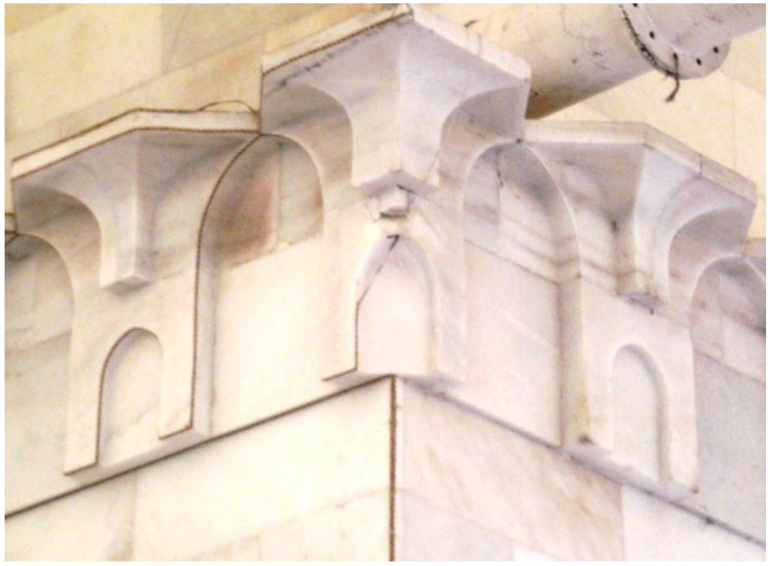Shk Ali Asghar M Saifuddin Lamuwala

Raudat Tahera is an architectural marvel in the heart of Mumbai embodying the vision of the two Dais resting therein, namely al-Dai al-Ajal Syedna Taher Saifuddin RA and al-Dai al-Ajal Syedna Mohammed Burhanuddin RA. Syedna Taher Saifuddin RA led the Dawoodi Bohra community for a grand 53 years in which he strengthened its spiritual, temporal and social aspects, until his sad demise on 19th Rajab 1385 AH (12th November 1965). His illustrious son and successor, Syedna Mohammed Burhanuddin RA then went on to lead the Community from strength to strength for a further half century that was replete with grand undertakings and notable achievements.
As Syedna Mohammed Burhanuddin RA recollects in one of his sermons, the most crucial task lying ahead after Syedna Saifuddin’s sad demise was of choosing an appropriate place for his burial. Ultimately, Qasre Husaini was chosen for the purpose which was the very place where the sepulchres of Maulana Ali b. Abi Talib SA and Maulana al-Imam al-Husain AS were constructed, upon Syedna Taher Saifuddin’s RA directives.

From various features of Fatimi architecture, Syedna Burhanuddin RA directed that the dome of al-Jami al-Juyushi be replicated in Raudat Tahera. He also ordained that spans of the mausoleum regarding length, breadth and height should conform to crucial markers of Syedna Taher Saifuddin’s RA lifetime or cater to important numbers in Fatimi lore. Hence, the following features were incorporated into the structure of Raudat Tahera:

- Raudat Tahera rests on a total of 92 pillars representing the Abjad numerical of the name of Mohammed which totals to 92.
- The height of Raudat Tahera is 108 ft. resembling the Abjad numerical of the word haqq.
- The inner height of Raudat Tahera is 80 ft. corresponding to the age that Syedna Saifuddin RA passed away at. A similar number of cornices represent this as well.
- The dome, along with its crown, rises to the height of 52 ft. representing Syedna Mohammed Burhanuddin RA being the 52nd Dai Mutlaq.
- The gold finial above the dome is 12 ft. in height; 12 being significant in various aspects of Fatimi doctrine.
- The four walls of Raudat Tahera have a total thickness of five ft. including the masonry wall and the cladding, which alludes to the Panjatan Paak or Khamsat Athaar SA. Similarly, there are five arches above each of the four silver doors of Raudat Tahera.
- Kufic script, a distinctive feature of Fatimi architecture, has been used for the inscriptions of the names of Aimmat Tahereen AS and Duat Mutlaqeen SA.
- The four entrances resemble the Fatimi doorway of al-Jami al-Aqmar in Cairo.
- The entrance doorways are named Raudat Tahera, Bab-e-Fakhri, Bab-e-Hakimi, and Bab-e-Zaini. The latter three are named after the ancestors of Syedna Taher Saifuddin RA: Syedi Fakhruddin al-Shaheed QR, Syedi Abdul Qadir Hakimuddin QR and Syedna Tayyib Zainuddin RA.
- The inner dimensions of the mausoleum, 51 x 51 ft., coincide with Syedna Saifuddin RA being the 51st Dai Mutlaq.

The blending of the old and time-tested with the new and beneficial is integral to Fatimi philosophy. Thus, alongside architectural features of the Fatimi era, Syedna Mohammed Burhanuddin RA ordained that the mausoleum be unprecedented in the history of Islamic architecture. He declared that the Quran in its entirety would be engraved in gold gilding on the walls of Raudat Tahera. A Quran used by Syedna Taher Saifuddin RA during his lifetime was replicated on 772 marble slabs within the edifice. All of the 114 Bismillahs, along with two whole Surahs; al-Fatiha and al-Ikhlas, were studded with rubies, diamonds, corals and emeralds. Syedna Taher Saifuddin RA had dedicated his entire life to following and promoting the teachings of the Quran Majeed. Hence, it was befitting that, after his demise, the Quran Majeed should grace his final resting place.

Moreover, this very act of embellishing Raudat Tahera with the entire Quran was an allusion to what was envisioned by Syedna Saifuddin RA and Syedna Burhanuddin RA i.e. that each Mumin live their life in accordance to its principles. Towards this vision, the engravings of Raudat Tahera would stand as a symbol of how a Mumin’s life should be guided by the teachings of the Quran Kareem. Working towards manifesting this intent, shortly after the inauguration of Raudat Tahera in 1395/1975, Syedna Burhanuddin RA established a dedicated institution in 1396 AH for the study and memorization of the Quran–Mahad al-Zahra.
Furthermore, in a way, engraving the Quran in its entirety was also a message of unity and mutual respect from Syedna al-Dai al-Ajal RA towards the global community. The Quran calls upon people of all faiths towards common terms (kalimat sawaa’). Similarly, Syedna Mohammed Burhanuddin RA called the global, especially Muslim, community towards unity and brotherhood. This is why, on the eve of Raudat Tahera’s inauguration, he invited various scholars and leaders to attend the ceremony from countries around the world including Algeria, Egypt, Lebanon, Syria, Jordan, Iraq, Kuwait, Tunisia, Iran and Yemen. In his speech, he remembered the efforts of Syedna Taher Saifuddin RA towards unifying the Islamic umma for the causes of Islam. On the occasion, a haflat al-Quran (a session for Quranic recitation) was also held where renowned reciters from Egypt and elsewhere took part, including the likes of Shaykh Mahmoud Khalil al-Husary and Shaykh Abdul Basit Abd us-Samad.

In a nutshell, the entity that is Raudat Tahera alludes to a deep underlying vision and a loftiness of purpose. Being centred on the Quran, it helps define the Community’s resolve towards total commitment to Islam. The mausoleum manifests Fatimi philosophy in its designs and architecture, testimony to the Community’s adherence to Fatimi faith and culture. Thus, Raudat Tahera, in its apparent simplicity yet exuberance of meaning, is a marvel celebrating the achievements of Syedna Taher Saifuddin RA, Syedna Mohammed Burhanuddin RA and their noble successor, al-Dai al-Ajal Syedna Mufaddal Saifuddin TUS. It is only through him that the values, vision and symbols embodied in Raudat Tahera are alive, vibrant and meaningful today.
Disclaimer–Viewpoints in blog posts do not necessarily reflect those of RadiantArts.
About the author–Shk. Ali Asghar M. Saifuddin Bhai Lamuwala graduated from Aljamea-tus-Saifiyah with an al-Faqih al-Jayyid degree in 1432/2012. He then obtained a M.Phil Degree in Islamic Studies from the University of Karachi in 1441/2020. He is currently a lecturer at Aljamea-tus-Saifiyah in Karachi, Pakistan.

Leave a comment
You must be logged in to post a comment.